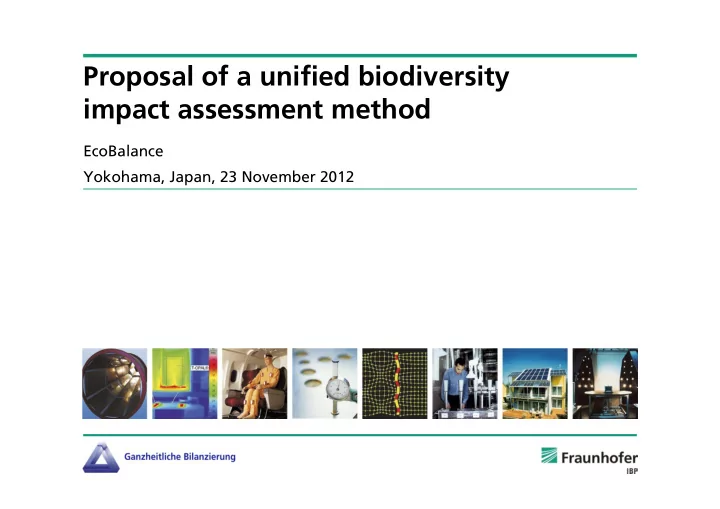

Proposal of a unified biodiversity impact assessment method EcoBalance Yokohama, Japan, 23 November 2012
Overview Context: land use in LCA Quantification of biodiversity: lack of normative conventions Quantification of biodiversity: approach Outlook
Context: land use in LCA Quality Q „Quality“ may refer e.g. to biodiversity Permanent impact Q ref Q rel Q 0 Temporary Q fin impact Area A t 0 t fin t rel Time t
Quantification of biodiversity: lack of normative conventions No globally unified definition of biodiversity Convention on biological diversity (CBD) Diversity within species Diversity between species Very generic high-level definition need for elaboration Diversity between ecosystems Millennium Ecosystem Assessment (MEA) Variability Quantity and quality Various aspects of biodiversity Distribution different goals
Quantification of biodiversity: lack of normative conventions No globally unified definition of biodiversity Ecosystem services (according to MEA) Provisioning services Supporting services Regulating services Various services provided by biodiversity different goals Cultural services The Economics of Ecosystems & Biodiversity (TEEB) Interpretation for economic decision processes Tangible values: substitution of technical solutions Intangible value: e.g. willingness to pay Pragmatic context-dependant valuation Problem: choice of valuation methods
Quantification of biodiversity: lack of normative conventions No recommendation for handling trade-offs between goals Few rare species vs many ubiquitous species Carriers of ecosystem services vs rarity Which ecosystem services? What does „rare“ mean? Naturalness = value in itself? Monetization Discounting Willingness to pay/accept Price elasticity
Quantification of biodiversity: approach
Quantification of biodiversity: approach Combination of the best aspects of existing methods + original development Biodiversity = global weighting × local constitution Weighting factor based on aspects of biodiversity with globally accepted relevance; locally specific aspects used to describe constitution Weighting factor can be interpreted as potential, local constitution as realization of potential Result: dimensionless index number, but points in the right direction High impact = not preferred Integration of various aspects and influences Enables aggregation and trade-off calculation
Quantification of biodiversity: approach Global weighting of regions Delineation: e.g. ecoregions, biomes, anthromes… Strong normative component Inclusion of relevant stakeholders Normative competence needed (e.g. authorities) or widely accepted (e.g. NGOs, experts) Potentially useful approaches, e.g. Relative species density (Koellner) Species numbers and rarity (Lindner) Species number, endemism, vulnerability of ecosystem (Brethauer) Biodiversity hotspots (Olson)
Quantification of biodiversity: approach Local description of constitution of biodiversity in the context of a regionally specific representation Literature research, expert interviews etc. What does biodiversity mean in that region? Which parameters constitute biodiversiy in that region? Literature research Laws Strategy documents Documentation of EIA processes Reports from conservation NGOs Scientific publications
Quantification of biodiversity: approach Biodiversity = f(x) f(x a ) x b f(x b ) x a
Quantification of biodiversity: approach Local description of constitution of biodiversity in the context of a regionally specific representation Regionally specific biodiversity potential function State = absolute level Change over parameter = (partial) deviation Inclusion of soft, semi-quantitative data through fuzzy modeling Transfer of qualitative data into quantitative contexts, enabling of use of calculation models Added information, not strictly scientifically verifiable, but with common sense and transparent documentation
Quantification of biodiversity: approach 1 2 n Biodiv Region 1 = f(x a , x b , x c …) Biodiv Region n Biodiv Region 2 = f(x I , x II , x III …)
Quantification of biodiversity: approach Guideline for expert interviews Preparation Literature research Choice of interview partners Questioning Relevance of ecosystems and species Transform fuzzy data into crisp data, get confirmation Topic matrix: e.g. diversity of ecological niches Physical/chemical, structural Space, time Conquest by neozoa/neophytes
Quantification of biodiversity: approach Literature, experts Definition, understanding Literature, experts Factors Literature, experts Parameter influence, (semi-)qualitative Fuzzy Modelling Parameter influence, quantitative Potential theory Influence of all parameters (potential function)
Quantification of biodiversity: approach Detailed, regionally specific biodiversity assessment and global aggregation Regional impact model 1 Reference state Global Parameter x a weighting Parameter x b Biodiversity reference Parameter x c Weighting Impact of factor w 1 alteration Total biodiversity impact Altered state Parameter x a Parameter x b Altered biodiversity Parameter x c Regional impact model 2 Parameters I, II, III… Biodiv reference Weighting Impact Parameters I, II, III… Altered biodiv factor w 2 Regional impact model n Parameters Biodiv reference Weighting Impact Parameters Altered biodiv factor w n
Outlook Project concludes in 2014 Methodology to be explicitly spelled out Calculation rules to be defined Quick test for efficient application of method Case studies with various land using companies Constructive criticism welcome!
Contact Jan Paul Lindner Dept. Life Cycle Engineering (GaBi) Fraunhofer IBP Wankelstrasse 5 70563 Stuttgart Tel 0711-970-3175 Fax 0711-970-3190 e-Mail jan-paul.lindner@ibp.fraunhofer.de This project is supported by the German Federal Agency for Nature Conservation (BfN) with funds from the German Federal Ministry for the Environment, Nature Conservation and Nuclear Safety (BMU). We are grateful for the support.
Recommend
More recommend